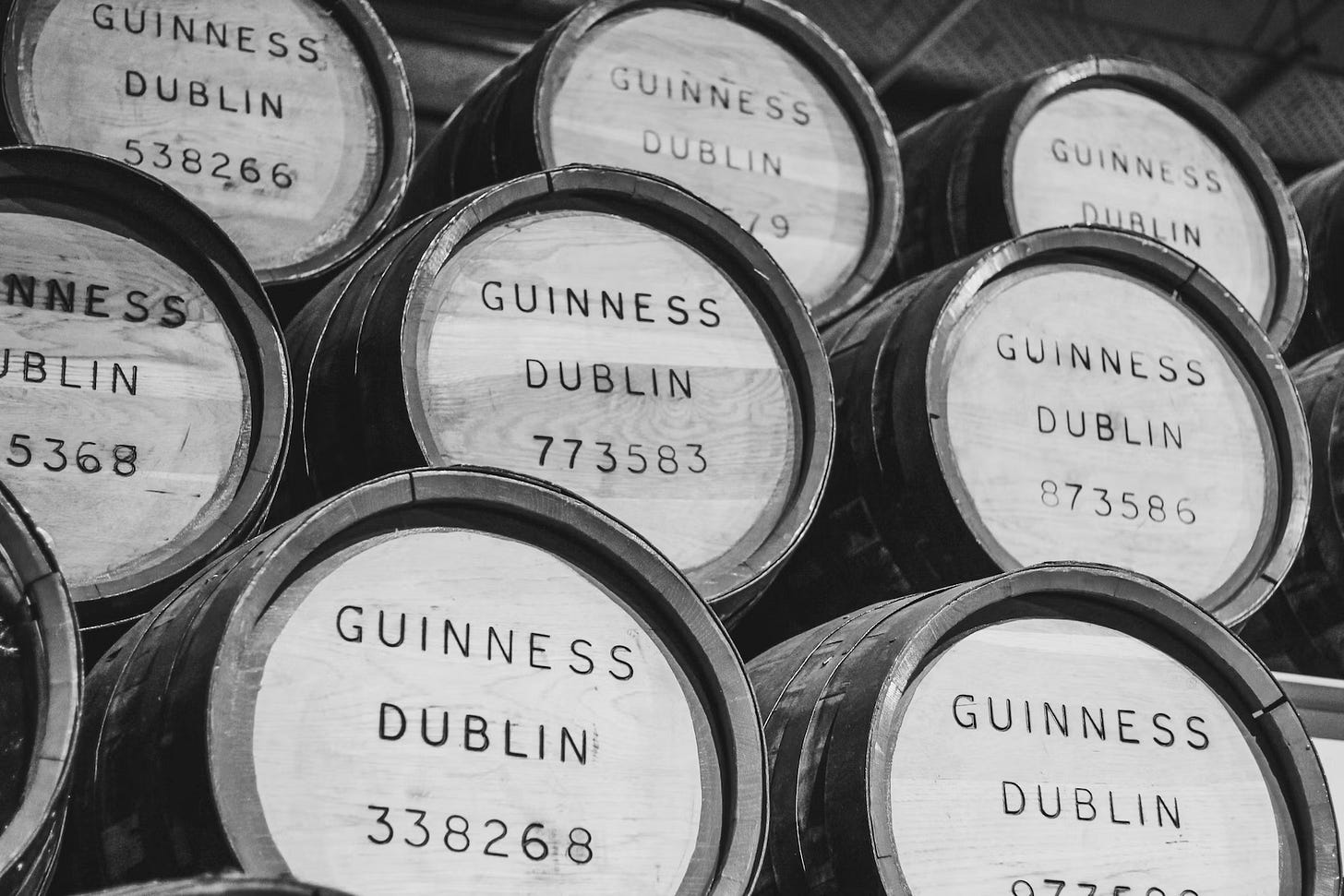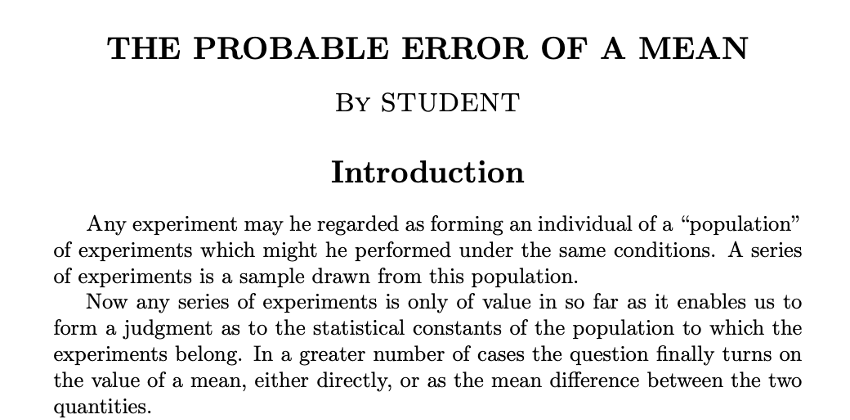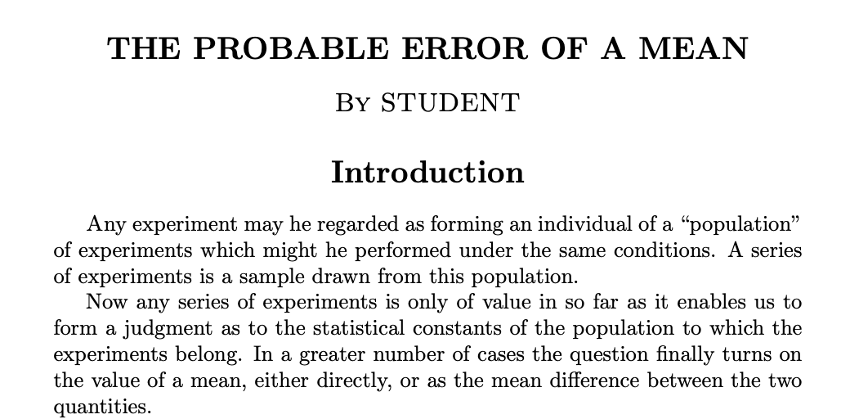Next time you do the Student's t-test you will remember this post: beer and statistics
How WS Gosset created a statistical technique that we frequently use to improve Guinness beer
Picture by Jessica Johnston
Versión es español más abajo
Student's t-test. If you like research, you know what I'm talking about. Sometimes there's a story behind the tools we use every day. And the story of the Student's t-test has to do with beer. With Guinness beer. And with a brewmaster, William Sealy Gosset. He was Student.
We use Student's t-test generally to test whether the means of a variable from two populations that follow a normal distribution are different. Guinness beer however is generally used to quench our thirst and delight us with its taste.
Gosset was born in 1876 in Canterbury, England, 151 years after the birth of Arthur Guinness. He studied chemistry and mathematics at Oxford.
The Guinness brewing company was the largest in the world by the time Gosset finished his studies. Guinness bet on an expansion of its business based on science, on the brightest minds, on studying and improving all phases from the cultivation of the grain until the beer is poured into the glass by a bartender in any city in the world. Science used to improve efficiency and increase profits.
Guinness had it clear, to hire a brewmaster, at least a degree from Oxford or Cambridge in some scientific discipline (natural sciences) was required.
So Gosset was hired by Guinness in 1899, right after graduating.
During his time as an apprentice brewer-scientist, he ran into a problem. He was investigating two of the essential components of beer, malt and hops. He wanted to make inferences, to detect significant differences in small samples of these components. The statistical techniques of the time, many of them developed by Pearson, were based on the analysis of large sample sizes, on the normal distribution.
Techniques had to be developed to analyze data from small samples, where the normal distribution failed. His bosses realized that if Gosset developed a statistical method for analyzing small samples, this could increase the company's profits by testing hypotheses to improve the beer production process, so they supported this line of work.
He stayed in Master Pearson's statistics laboratory for 1 year, and at that time he matured and published his paper "The Probable Error of a Mean" (1908). He did not put his name, but a pseudonym, Student. It seems that he chose it from the cover of a notebook used at that time called "The Student's Science Notebook".
He signed the article that would later make him famous with a pseudonym because Guinness only allowed its employees to write scientific articles if they did not identify themselves as employees of the company, did not mention the beer or give their name, so as not to give clues to competitors about techniques to improve their beers and lose market share.
Gosset was an excellent brewer, progressing through Guinness to become Head Brewer at the Guinness plant in London, and then Head Brewer for all of Guinness, a position he enjoyed for only one month when he died of a heart attack at the age of 61.
Student's paper went unnoticed at the time of its publication, but another great statistician, Ronald Fisher, popularized Student's distribution in his book Statistical Methods for Research Workers (1925).
The next time you do the Student's t-test, remember that it was malt and hops that moved Gosset to create this statistical tool that is used in sciences such as medicine, biometrics, economics and other disciplines.
Curiosities
The family origins of Arthur Guinness have been the subject of a genetic study by the Trinity College.
I don't like Guinness beer, sorry Gosset! But I love the Student's t-test.
We are already 1000 subscribers of DeMadaria Vs. Placebo. Thank you so much for being a #ClinicalResearchLover!
No artificial intelligence programs have been used in this newsletter.
Bibliography
Stephen T. Ziliak, 2008. Guinnessometrics: The Economic Foundation of “Student’s” t. Journal of Economic Perspectives.
Martin Leenane 2020. W.S. Gosset; Student, Statistician and Brewer.
Angus Brown, 2008. The strange origins of the Student’s t-test.
*******
Versión en español
El test de la t de Student. Si te gusta la investigación sabes de lo que hablo. A veces detrás de las herramientas que usamos cotidianamente hay una historia. Y la historia de la T de Student tiene que ver con la cerveza. Con la cerveza Guinness. Y con un maestro cervecero, William Sealy Gosset. Él fue Student.
Usamos el test de la t de Student generalmente para comprobar si las medias de una variable de dos poblaciones que siguen una distribución normal son diferentes. La cerveza Guinness sin embargo se usa generalmente para saciar nuestra sed y deleitarnos con su sabor.
Gosset nació en 1876 en Canterbury, Inglaterra, 151 años después del nacimiento de Arthur Guinness. Estudió química y matemáticas en Oxford.
La empresa cervecera Guinness era la mayor del mundo en el momento en que Gosset acabó de estudiar. Guinness apostó por una expansión de su negocio basada en la ciencia, en las mentes más brillantes, en estudiar y mejorar todas las fases comprendidas desde el cultivo de los cereales hasta que la cerveza es vertida en el vaso por un barman en cualquier ciudad del mundo. Ciencia usada para mejorar la eficiencia y aumentar las ganancias.
Guinness lo tenía claro, para contratar a un maestro cervecero se requería al menos un grado en Oxford o Cambridge en alguna disciplina científica (ciencias naturales).
Así Gosset fue contratado por Guinness en 1899, nada más graduarse.
Durante su época de aprendiz de cervecero-científico, se topó con un problema. Investigaba dos de los componentes esenciales de la cerveza, la malta y el lúpulo. Quería hacer inferencias, detectar diferencias significativas en pequeñas muestras de estos componentes. Las técnicas estadísticas de la época, muchas de ellas desarrolladas por Pearson, se basaban en el análisis de muestras de gran tamaño, en la distribución normal.
Había que desarrollar técnicas para analizar datos provenientes de muestras pequeñas, donde la distribución normal fallaba. Sus jefes se dieron cuenta de que si Gosset desarrollaba un método estadístico para analizar muestras pequeñas, esto podría aumentar los beneficios de la compañía, al poder testar hipótesis para mejorar el proceso productivo de la cerveza de forma que apoyaron esta línea de trabajo.
Hizo una estancia en el laboratorio de estadística del Maestro Pearson durante 1 año, y en esa época maduró y publicó su artículo “The Probable Error of a Mean” (1908). No puso su nombre, sino un pseudónimo, Student. Parece ser que lo eligió de la portada de un cuaderno de notas usado en esa época llamado "The Student’s Science Notebook".
Artículo original de Gosset/Student
Firmó el artículo que más tarde le haría famoso con un pseudónimo porque Guinness sólo permitía que sus empleados escribieran artículos científicos si no se identificaban como empleados de la empresa, no mencionaban la cerveza ni daban su nombre, para no dar pistas a la competencia sobre técnicas para mejorar sus cervezas y perder cuota de mercado.
Gosset fue un excelente cervecero, progresando en Guinness hasta convertirse en Jefe Cervecero (Head Brewer) en la planta Guinness de Londres, y luego Jefe Cervecero de todo Guinness, puesto del que solo disfrutó un mes ya que falleció de un ataque al corazón a los 61 años.
El escrito de Student pasó desapercibido en el momento de su publicación, pero otro gran estadístico, Ronald Fisher, popularizó la t de student en su libro Statistical Methods for Research Workers (1925).
La próxima vez que hagas la test de la t de Student, recuerda que fue la malta y el lúpulo lo que movió a Gosset a crear esa herramienta estadística que se usa en ciencias como la medicina, biométrica, la economía u otras disciplinas.
Curiosidades
Los orígenes familiares de Arthur Guinness han sido objeto de un estudio genético por el Trinity College de Dublín
No me gusta la cerveza Guinness, ¡lo siento mucho Gosset! Pero me encanta el test de la t de Student.
¡Ya somos 1000 suscriptores de DeMadaria Vs. Placebo! Muchas gracias por ser un #ClinicalResearchLover
En esta Newsletter no se han usado programas de inteligencia artificial.
Bibliografía
Stephen T. Ziliak, 2008. Guinnessometrics: The Economic Foundation of “Student’s” t. Journal of Economic Perspectives.
Martin Leenane 2020. W.S. Gosset; Student, Statistician and Brewer.
Angus Brown, 2008. The strange origins of the Student’s t-test.







